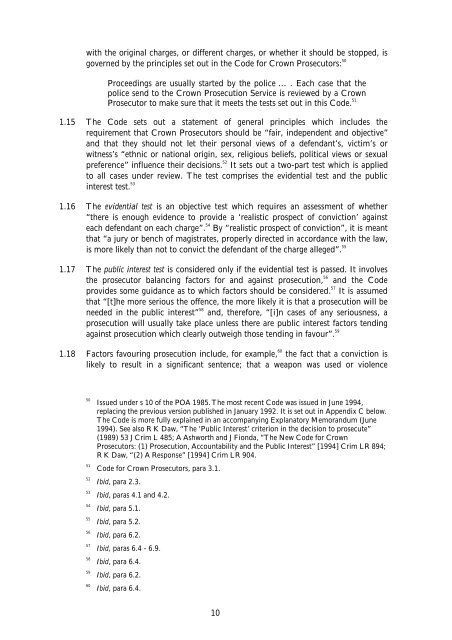cp149 Consents to Prosecution consultation - Law Commission
cp149 Consents to Prosecution consultation - Law Commission
cp149 Consents to Prosecution consultation - Law Commission
You also want an ePaper? Increase the reach of your titles
YUMPU automatically turns print PDFs into web optimized ePapers that Google loves.
with the original charges, or different charges, or whether it should be s<strong>to</strong>pped, is<br />
governed by the principles set out in the Code for Crown Prosecu<strong>to</strong>rs: 50<br />
Proceedings are usually started by the police … . Each case that the<br />
police send <strong>to</strong> the Crown <strong>Prosecution</strong> Service is reviewed by a Crown<br />
Prosecu<strong>to</strong>r <strong>to</strong> make sure that it meets the tests set out in this Code. 51<br />
1.15 The Code sets out a statement of general principles which includes the<br />
requirement that Crown Prosecu<strong>to</strong>rs should be “fair, independent and objective”<br />
and that they should not let their personal views of a defendant’s, victim’s or<br />
witness’s “ethnic or national origin, sex, religious beliefs, political views or sexual<br />
preference” influence their decisions. 52<br />
It sets out a two-part test which is applied<br />
<strong>to</strong> all cases under review. The test comprises the evidential test and the public<br />
interest test. 53<br />
1.16 The evidential test is an objective test which requires an assessment of whether<br />
“there is enough evidence <strong>to</strong> provide a ‘realistic prospect of conviction’ against<br />
each defendant on each charge”. 54<br />
By “realistic prospect of conviction”, it is meant<br />
that “a jury or bench of magistrates, properly directed in accordance with the law,<br />
is more likely than not <strong>to</strong> convict the defendant of the charge alleged”. 55<br />
1.17 The public interest test is considered only if the evidential test is passed. It involves<br />
the prosecu<strong>to</strong>r balancing fac<strong>to</strong>rs for and against prosecution, 56<br />
and the Code<br />
provides some guidance as <strong>to</strong> which fac<strong>to</strong>rs should be considered. 57<br />
It is assumed<br />
that “[t]he more serious the offence, the more likely it is that a prosecution will be<br />
needed in the public interest” 58<br />
and, therefore, “[i]n cases of any seriousness, a<br />
prosecution will usually take place unless there are public interest fac<strong>to</strong>rs tending<br />
against prosecution which clearly outweigh those tending in favour”. 59<br />
1.18 Fac<strong>to</strong>rs favouring prosecution include, for example, 60<br />
the fact that a conviction is<br />
likely <strong>to</strong> result in a significant sentence; that a weapon was used or violence<br />
50 Issued under s 10 of the POA 1985. The most recent Code was issued in June 1994,<br />
replacing the previous version published in January 1992. It is set out in Appendix C below.<br />
The Code is more fully explained in an accompanying Explana<strong>to</strong>ry Memorandum (June<br />
1994). See also R K Daw, “The ‘Public Interest’ criterion in the decision <strong>to</strong> prosecute”<br />
(1989) 53 J Crim L 485; A Ashworth and J Fionda, “The New Code for Crown<br />
Prosecu<strong>to</strong>rs: (1) <strong>Prosecution</strong>, Accountability and the Public Interest” [1994] Crim LR 894;<br />
R K Daw, “(2) A Response” [1994] Crim LR 904.<br />
51 Code for Crown Prosecu<strong>to</strong>rs, para 3.1.<br />
52 Ibid, para 2.3.<br />
53 Ibid, paras 4.1 and 4.2.<br />
54 Ibid, para 5.1.<br />
55 Ibid, para 5.2.<br />
56 Ibid, para 6.2.<br />
57 Ibid, paras 6.4 - 6.9.<br />
58 Ibid, para 6.4.<br />
59 Ibid, para 6.2.<br />
60 Ibid, para 6.4.<br />
10
















